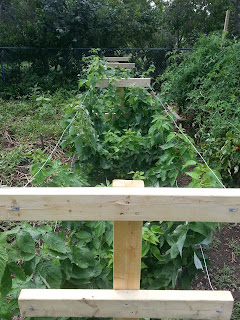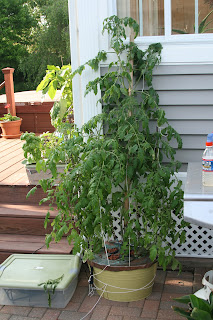So I have been super awful at keeping up with my endeavors online since things went awry in the spring, but I have continued endeavoring! And over the course of the summer my family and I have had a few successes despite some crazy weather for MA (We had perpetual rain for some weeks, tornadoes, hail, hurricanes, early frosts, and snow in october!).
The three tomato plants that I started in the spring are probably what did the best of anything. At their peak I was harvesting a large bowl full of heirloom tomatoes daily! They were super delicious. Up until earlier this year I never ate tomatoes, even on anything, and I would eat the yellow pears right off the vine daily. The yellow pears were the most prolific of the three by far, my speculation is that it was because of the placement of the plants in the system; the yellow pear was in the center, directly over the primary of the two airstones I had in the system, and the most area to grow due to the shape of the basin which the water was in. Aside from the fogger, which was removed mid-season, the system contained no plastics whatsoever. It is hard to see in the pictures, but I built a support cage out of chicken mesh, and used an old shovel handle to hold the plants up.
These first two pictures are from just before, and just after moving from inside to outside.
They took a bit of a beating, especially the yellow pear (center/ tallest). Taken in late May.
These are from a couple days, and about a month later
After some overzealous branching up top in late July, my tying up gave way and the whole bush started to fall over, so I put a 12 foot 2"x4" in the ground next to it and began tying it up. It reached about eight or nine feet before we got hit by a hurricane, and some sort of a mold/mildew/fungus took out all of the tomatoes in the area.
Also in this system, I rooted my new pineapple plant!
Next to the tomatoes, the other hydroponic things did pretty well. A DWC system which I had set up for my mom in the spring, which had three basil plants and a pepper produced a number of peppers and good deal of basil, though the pepper overshadowed a little. This system survived hell, the pepper plant, and even the whole system were blown over multiple times, causing branches to break off. There was also a twelve site fog culture planted with two peppers and eight or so basil plants of assorted varieties. It was not the best fogger system set-up, a lot of sediment built up on the fogger which clogged it. But none the less it was very bountiful, we made multiple pesto dishes throughout the summer simply through picking little bits off, and then when we really harvested, we made dozens of 4-8oz jars of pesto with it.
All of these pictures are from very early in the season, by the end everything was much larger.
Before move outside.
After move outside.


Though I shelved my indoor systems for the summer, I did set up one simple, experimental ‘garden’. I built a table out of scrap wood we had laying around and cut two holes in it the size of a five gallon bucket. Then I built something of a light box around it, and lined it with reflective film on all sides. I planted five basil plants in each bucket, placed one new airstone in each bucket, fed by the same pump. If I had light on, it was equidistant from each bucket. The one difference between the two buckets was that in-line to the airstone of one bucket I placed an algaculture relay system. In theory, via passing the air through an active algaculture, the oxygen content will rise in the air relative to the external atmosphere, thereby diffusing a higher oxygen content into the DWC nutrient solution. In practice, I took a clear mason jar, drilled two holes in the lid, ran a line-in which was to be submerged in nutrient water (to the bottom of the jar), then ran a line-out which was mounted just enough into the jar to be sealed, this was all sealed air tight with hot glue (silicon caulk in the future), the jar was filled with nutrient water leaving a small gap, I inoculated the solution with algae from a fish tank, and the lid was tightened on. The plants in each bucket grew equitably while the jar was establishing. It took a while to get established, but eventually the jar was a vibrant green and all surfaces were thick with algae. I then cut all plants back to the base-most node placing them on the same level literally and figuratively. Effect, after leaving them to grow freely all summer, the plants in the inline-algaculture-bucket were substantially taller, approx. 140% taller (~ 4-6 in.). I don’t consider this at all definitive, and I will likely try the experiment again, multiple times, before I am positive it is beneficial. The idea being that as with all life, plants use oxygen, especially at night, especially in the roots, so increasing the atmospheric oxygen in the root zone would potentially increase growth in some capacity. Whatever the end result, these plants produced wonderfully. Unfortunately it was too close quarters to get any good photos.
This is all of the basil we grew, inside/outside, soil/hydroponics from the night we made pesto.
Top is from soil plants.
Bottom left is outdoor DWC.
Bottom right is from my experimental DWC.
Now for the soil. It was super wet this year, and as I previously said we had some intense weather. But we have an extensive garden and some things did quite well. Potatoes, we grew nine different heirloom varieties, and we actually bought another fridge to store them all. The soil tomatoes (as well as the hydroponics, though earlier) were attacked by a mold, mildew, or fungus in the area and took a hit for it. Beans did okay though we had some pole beans labelled bush and vice versa, so we didn’t have the proper set-up for maximum yield. We planted strawberries, and they spread like wildfire, and produced some fruit. Onions did well, beets not so much. And as always we had plenty of lettuce, kale, chard.
This is the primary part of our soil garden, before much had sprouted. In the center are onions, chard, lettuce, beets, spinach. To the right of the central tree was all potatoes, ~25'x25'. To the left of the tree out to the rope was all corn, but it didn't do fantastically. And in the back left were our soil tomatoes. Kale and broccoli scattered everywhere.
The next picture is from what is now our berry patch off on the northern side-lot of our yard. Four blueberries, and a lot of strawberries (even more now!) this has all been covered in mesh. Just out of frame to the left were our beans and some cucumbers. An the picture to the right is of one of our cold-frames which we use to start plants outdoors before it is warm enough, and now to keep our lettuce alive past frosts and even snow this year.
I will likely be posting again soon, with the summer gone, and winter quickly approaching, I will be bringing much more life back indoors. I have a few hydroponic things that I worked on, but never planted anything in due to timing which I will post some designs and pictures of. And my WindowFarm(s) will be running and planted again in the next couple of weeks, so stay tuned, follow to be notified of any updates, and keep farmin'! Namaste.






















































